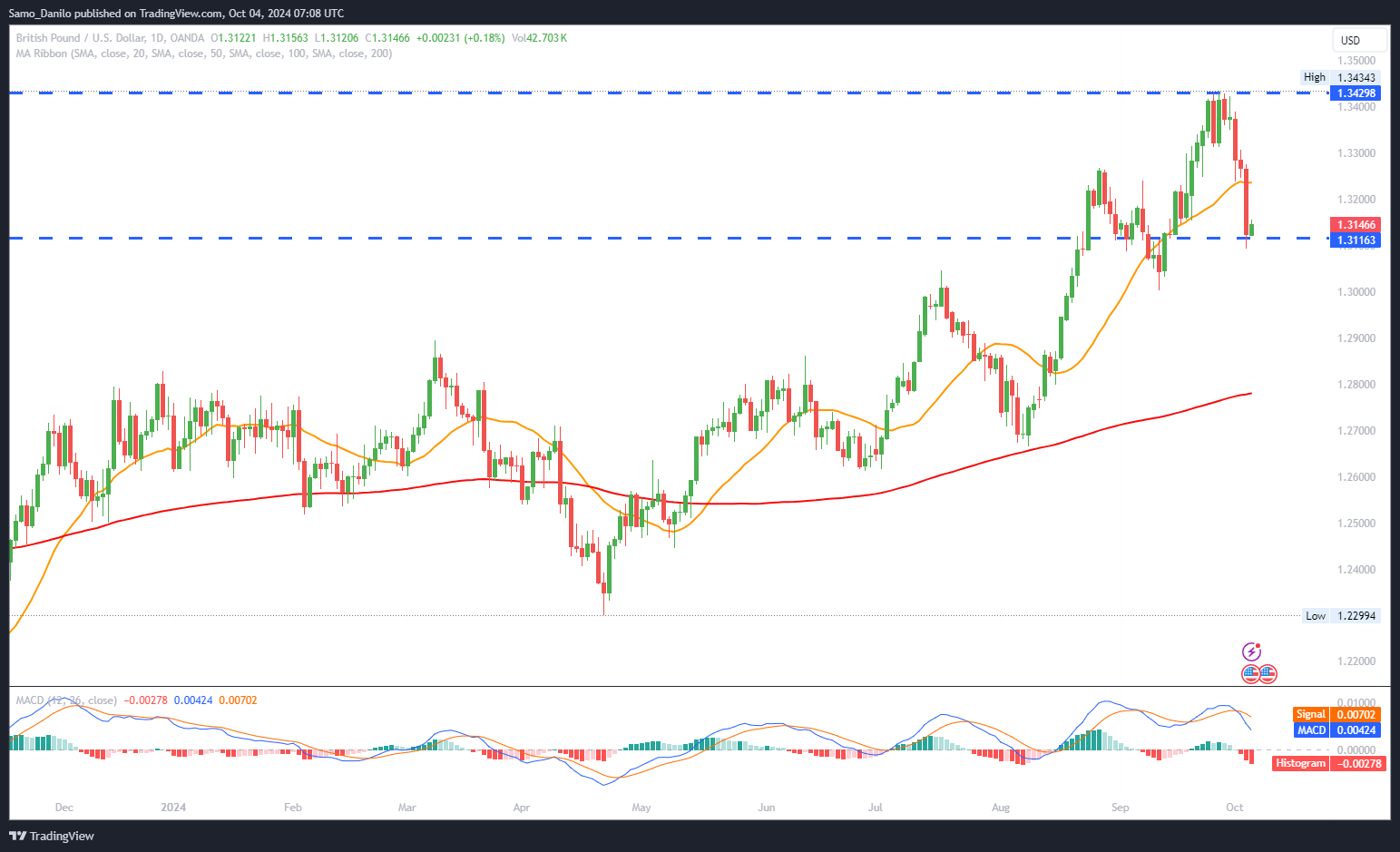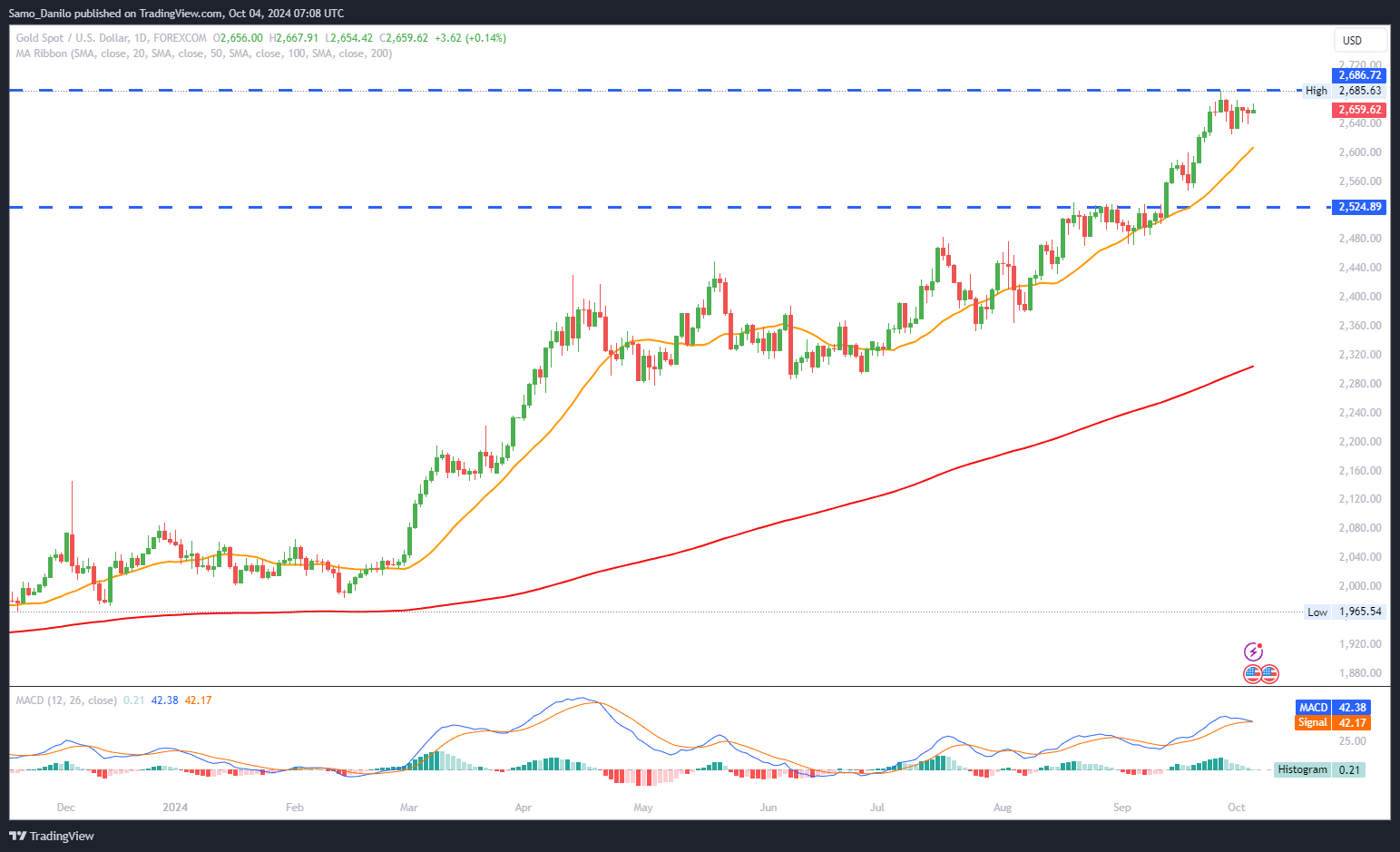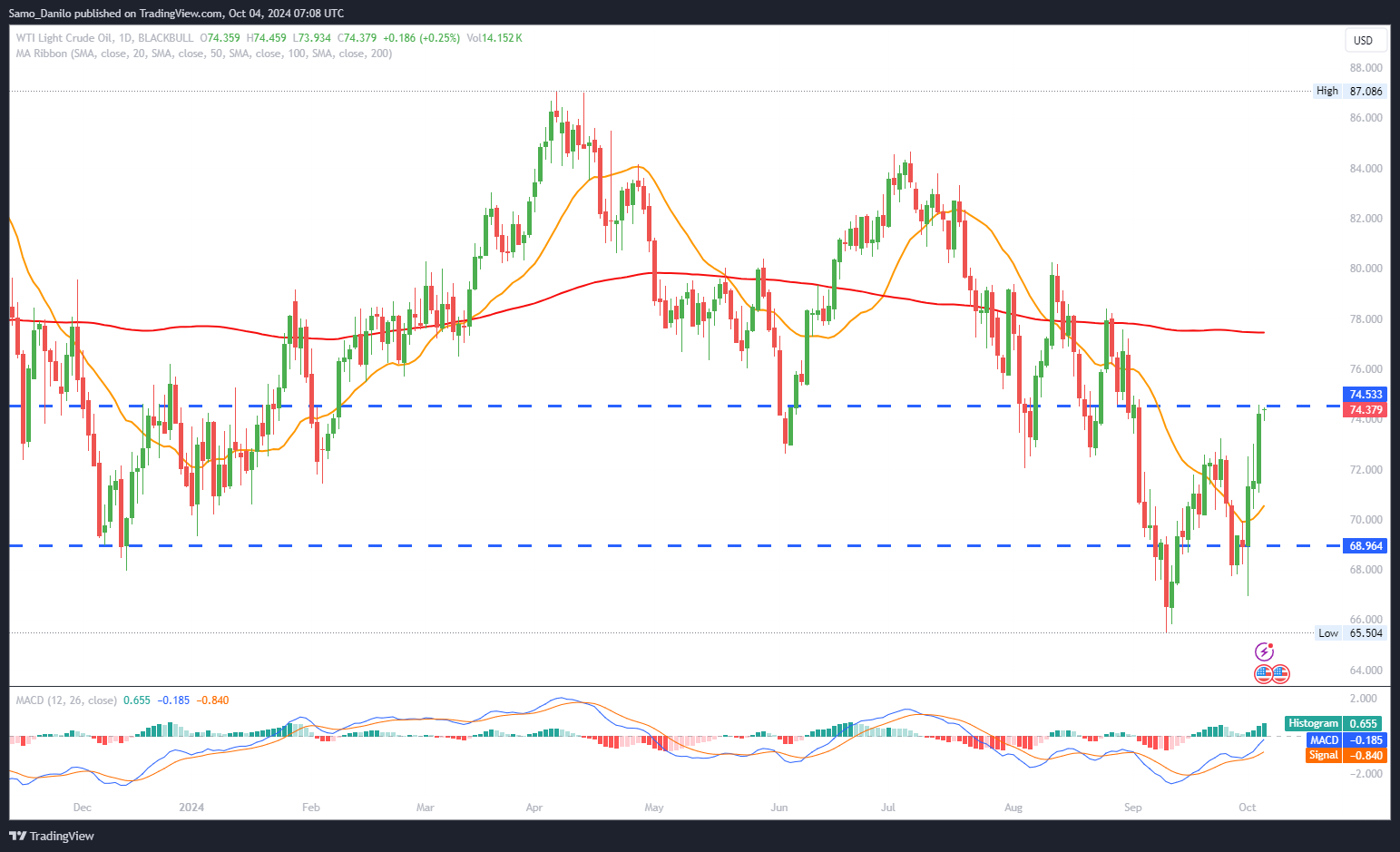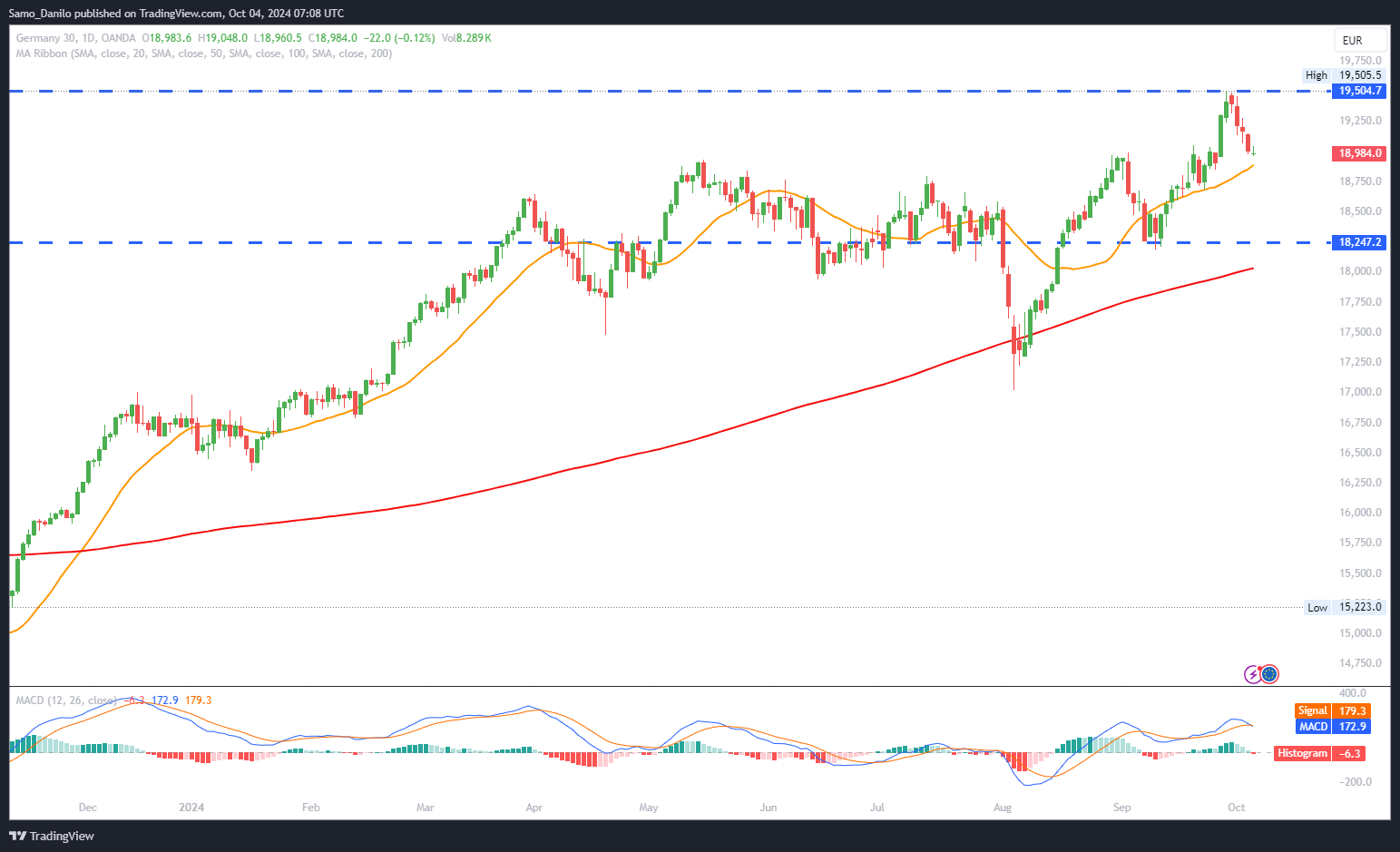EURUSD
- Price Movement: EUR/USD remains on the defensive, trading below the 1.1050 level in early Friday trading. The pair is struggling to find clear direction as market participants adopt a cautious stance ahead of crucial US economic data, limiting any significant price movement.
- ECB Rate Cut Expectations: Lower-than-expected Eurozone inflation has increased the likelihood of a rate cut by the ECB in October, which would be the third reduction this year. This dovish outlook is pressuring the Euro, as traders anticipate a more accommodative policy stance from the central bank.
- Geopolitical Risks: The Euro, being a risk-sensitive currency, is facing additional headwinds from escalating geopolitical tensions in the Middle East. Comments from US President Joe Biden indicating discussions with Israel about potential strikes on Iran’s oil infrastructure are creating risk-off sentiment, which is favouring the safe- haven US Dollar.
- US Economic Data: The USD continues to benefit from robust US economic data, including better-than-expected ISM Services PMI and ADP Employment Change reports. These releases have dampened dovish expectations for the Federal Reserve, providing further support for the USD and driving EUR/USD lower.
- Nonfarm Payrolls Data: Traders are refraining from making large moves in EUR/USD ahead of the upcoming US Nonfarm Payrolls data. This report will be crucial for determining the Fed’s next policy steps and could provide the directional impetus needed to push the pair decisively above or below current levels.
Closing statement: EUR/USD is trading defensively below 1.1050 amid mounting expectations of an ECB rate cut and ongoing geopolitical risks. The pair’s outlook remains uncertain, as traders are holding back ahead of the critical US Nonfarm Payrolls release, which could set the tone for the Fed’s policy path and dictate the next significant move for EUR/USD. A strong payrolls report could drive the pair lower, while a disappointing result may offer some relief to the Euro.
GBPUSD
- Price Movement: GBP/USD is trading near 1.3125 during the Asian session on Friday, struggling to gain momentum. The pair’s subdued performance reflects a cautious market sentiment, as traders await key US economic data for directional cues.
- BoE Comments: Bank of England (BoE) Governor Andrew Bailey’s dovish remarks on Thursday have weakened the GBP, signalling a shift toward a more accommodative monetary policy stance. This has dampened the Pound’s appeal, as traders factor in increased odds of a rate cut at the November meeting.
- Rate Cut Expectations: The BoE is now widely expected to cut rates by 25 basis points in November, with the probability of a second cut in December also rising. These expectations are adding to the downside pressure on the GBP, as the central bank’s easing stance contrasts with a relatively firm US Dollar.
- Geopolitical Tensions: Escalating tensions in the Middle East are boosting demand for safe-haven assets, including the USD. Concerns over a broader conflict in the region are providing additional support to the Greenback, making it difficult for the Pound to recover.
- US Economic Data: Traders are sidelined ahead of the upcoming US Nonfarm Payrolls, Unemployment Rate, and Average Hourly Earnings data releases later Friday. These reports will be critical in shaping expectations for the Federal Reserve’s next policy move and could lead to heightened volatility in GBP/USD.
| SMA (20) | Rising |
|
|
| RSI (14) | Falling |
|
|
| MACD (12, 26, 9) | Slightly Falling |
|
Closing statement: GBP/USD is trading cautiously around 1.3125, weighed down by dovish BoE comments and rising expectations of a rate cut in November. The pair is likely to remain under pressure unless the upcoming US Nonfarm Payrolls report disappoints, which could trigger a temporary relief rally. Otherwise, stronger-than-expected US data may push GBP/USD lower, particularly if geopolitical tensions continue to support the USD.
GOLD
- Price Action: Gold is struggling to gain traction and remains confined within a familiar range established since the beginning of the week. This sideways movement indicates a lack of strong directional impetus as traders balance mixed fundamental cues and await further clarity from upcoming economic data.
- Technical Outlook: From a technical perspective, the ongoing consolidation phase can still be considered a bullish pause. This follows the recent sharp run-up to record highs, suggesting that gold might be gathering momentum for a potential breakout if bullish drivers resurface.
- USD Pullback: The US Dollar has retreated slightly from its one-month peak reached on Thursday, stalling its recent recovery move. This minor USD weakness is helping gold hold its ground, but any renewed strength in the Greenback could quickly pressure the precious metal lower.
- US Labor Market: The US Department of Labor reported a slight increase in initial jobless claims, which rose to 225K for the week ending September 28 from 218K previously. While the increase is minor, it hints at some potential cooling in the labor market, which could support expectations for a more dovish Fed policy stance.
- US Nonfarm Payrolls: Traders are closely watching the upcoming US Nonfarm Payrolls (NFP) report. The consensus is for an addition of 140K jobs in September, slightly lower than the previous 142K, with the Unemployment Rate expected to hold steady at 4.2%. The outcome will be pivotal in shaping Gold’s next move, as it could heavily influence the Fed’s interest rate outlook.
| SMA (20) | Rising |
|
|
| RSI (14) | Rising |
|
|
| MACD (12, 26, 9) | Rising |
|
|
Closing statement: Gold remains trapped in a range, awaiting a clear catalyst to break free. While technicals suggest a bullish bias, the direction of XAU/USD will largely depend on the outcome of the US Nonfarm Payrolls report. A weaker-than-expected NFP could fuel a rally toward new highs, while a strong print might push gold lower, especially if it rekindles USD strength and expectations for tighter Fed policy.
CRUDE OIL
- Price Gains: West Texas Intermediate (WTI) Crude Oil is trading around $73.60 per barrel during the European session on Friday, marking its fourth consecutive day of gains. The commodity is showing a strong weekly performance, reflecting heightened market sentiment driven by recent geopolitical developments.
- Geopolitical Tensions: Rising geopolitical tensions in the Middle East are providing substantial support to Oil prices, as traders worry about potential disruptions in supply from a region responsible for about one-third of global crude output. Concerns are particularly focused on potential supply shocks if the conflict escalates further.
- US and Israel Statements: Statements from US President Joe Biden and Israeli Prime Minister Benjamin Netanyahu have added to the uncertainty, as both nations consider potential strikes on Iran’s oil infrastructure. These comments have stoked fears of a broader conflict, which could significantly impact oil supply and lead to further price spikes.
- OPEC+ Readiness: Despite the geopolitical risks, OPEC+ has indicated that it has sufficient spare capacity to offset a complete loss of Iranian supply if necessary. This assurance has helped temper some of the bullish sentiment, but any escalation could still strain OPEC+’s ability to stabilize the market.
- Libya’s Oil Reopening: Libya’s recent decision to reopen all oilfields and export terminals after resolving a leadership dispute at the central bank has added some relief to the supply outlook. While this development is positive for crude availability, its impact may be limited if geopolitical tensions continue to escalate.
| SMA (20) | Falling |
|
|
| RSI (14) | Rising |
|
|
| MACD (12, 26, 9) | Slightly Rising |
|
Closing statement: WTI Crude Oil is enjoying a strong rally, underpinned by geopolitical concerns in the Middle East and fears of potential supply disruptions. Although OPEC+’s readiness to manage supply shocks and Libya’s reopening of oilfields provide some reassurance, the outlook remains bullish as long as the geopolitical situation remains uncertain. Any further escalation could drive prices higher, especially if Iran’s oil infrastructure is directly targeted.
DAX
- Auto Stocks: Auto stocks extended their decline for a fourth consecutive session, pressured by fading expectations for aggressive Federal Reserve rate cuts, escalating Middle East tensions, and a negative outlook for sector profitability. Stellantis’ announcement of potential cuts to its dividend and share buybacks has further dented investor confidence, fueling the ongoing pullback in the auto segment.
- Weak Eurozone Services PMI: The Eurozone’s Services PMI fell to a seven-month low of 51.4 in September, down from 52.9 in August, signaling a slowdown in economic activity. Notably, new orders declined for the first time since February, casting a bleak outlook for the Eurozone economy and dampening sentiment for DAX-listed companies exposed to regional demand.
- Geopolitical Risks: Rising expectations of an Israeli strike on Iran’s oil facilities are heightening geopolitical risks, which could weigh heavily on the DAX. Should tensions escalate further, the index might break below the critical 19,000 level, driven by a broader flight to safety and potential disruptions in global supply chains.
- US Economic Data: On Thursday, US jobless claims and services sector data weakened the case for a 50-basis point rate cut by the Federal Reserve. This moderation in rate cut expectations is affecting global risk sentiment, impacting the demand for European equities, including those on the DAX.
- US Nonfarm Payrolls: Investors are keenly awaiting the US Jobs Report due on Friday. Economists predict a rise of 142k in nonfarm payrolls for September, slightly above the 140k increase in August, and expect the unemployment rate to remain steady at 4.2%. The data could significantly influence market risk appetite and set the tone for the DAX’s near-term trajectory.
| SMA (20) | Rising |
|
|
| RSI (14) | Slightly Rising |
| |
| MACD (12, 26, 9) | Rising |
|
|
Closing statement: The DAX is under pressure amid ongoing losses in the auto sector, a weaker Eurozone Services PMI, and rising geopolitical tensions. Investors are on edge ahead of the US Nonfarm Payrolls report, which could further influence the index’s movement. If geopolitical tensions escalate or US job data surprises significantly, the DAX could see heightened volatility, with a potential break below 19,000 if risk aversion intensifies.




